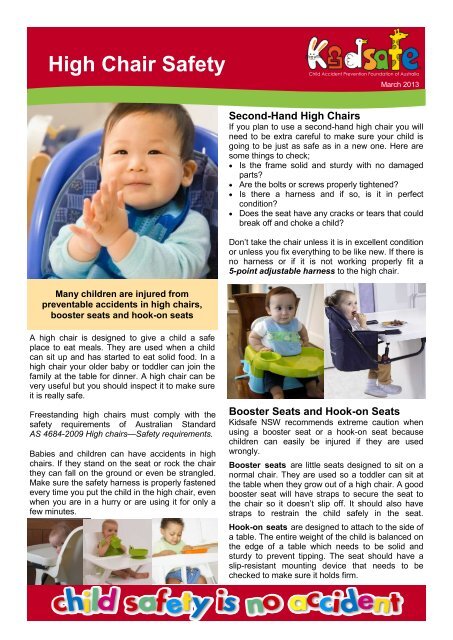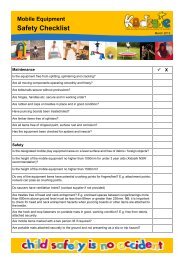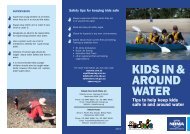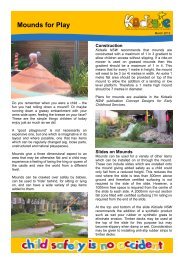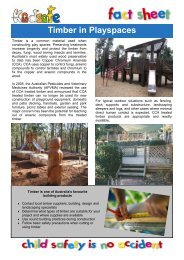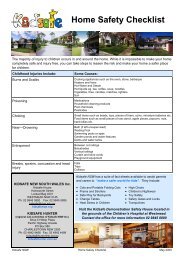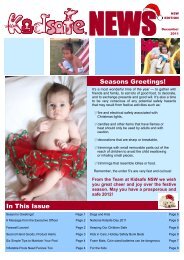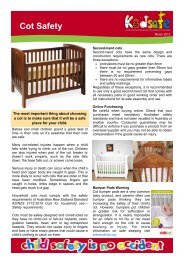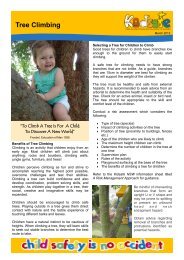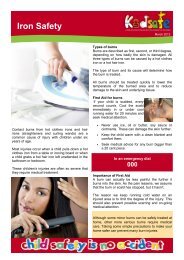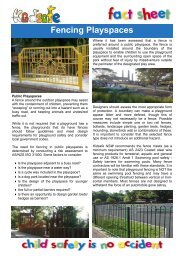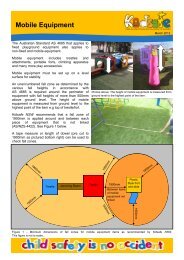High Chair Safety - Kidsafe NSW
High Chair Safety - Kidsafe NSW
High Chair Safety - Kidsafe NSW
Create successful ePaper yourself
Turn your PDF publications into a flip-book with our unique Google optimized e-Paper software.
<strong>High</strong> <strong>Chair</strong> <strong>Safety</strong><br />
Child Accident Prevention Foundation of Australia<br />
March 2013<br />
Second-Hand <strong>High</strong> <strong>Chair</strong>s<br />
If you plan to use a second-hand high chair you will<br />
need to be extra careful to make sure your child is<br />
going to be just as safe as in a new one. Here are<br />
some things to check;<br />
Is the frame solid and sturdy with no damaged<br />
parts?<br />
Are the bolts or screws properly tightened?<br />
Is there a harness and if so, is it in perfect<br />
condition?<br />
Does the seat have any cracks or tears that could<br />
break off and choke a child?<br />
Don’t take the chair unless it is in excellent condition<br />
or unless you fix everything to be like new. If there is<br />
no harness or if it is not working properly fit a<br />
5-point adjustable harness to the high chair.<br />
Many children are injured from<br />
preventable accidents in high chairs,<br />
booster seats and hook-on seats<br />
A high chair is designed to give a child a safe<br />
place to eat meals. They are used when a child<br />
can sit up and has started to eat solid food. In a<br />
high chair your older baby or toddler can join the<br />
family at the table for dinner. A high chair can be<br />
very useful but you should inspect it to make sure<br />
it is really safe.<br />
Freestanding high chairs must comply with the<br />
safety requirements of Australian Standard<br />
AS 4684-2009 <strong>High</strong> chairs—<strong>Safety</strong> requirements.<br />
Babies and children can have accidents in high<br />
chairs. If they stand on the seat or rock the chair<br />
they can fall on the ground or even be strangled.<br />
Make sure the safety harness is properly fastened<br />
every time you put the child in the high chair, even<br />
when you are in a hurry or are using it for only a<br />
few minutes.<br />
Booster Seats and Hook-on Seats<br />
<strong>Kidsafe</strong> <strong>NSW</strong> recommends extreme caution when<br />
using a booster seat or a hook-on seat because<br />
children can easily be injured if they are used<br />
wrongly.<br />
Booster seats are little seats designed to sit on a<br />
normal chair. They are used so a toddler can sit at<br />
the table when they grow out of a high chair. A good<br />
booster seat will have straps to secure the seat to<br />
the chair so it doesn’t slip off. It should also have<br />
straps to restrain the child safely in the seat.<br />
Hook-on seats are designed to attach to the side of<br />
a table. The entire weight of the child is balanced on<br />
the edge of a table which needs to be solid and<br />
sturdy to prevent tipping. The seat should have a<br />
slip-resistant mounting device that needs to be<br />
checked to make sure it holds firm.
<strong>Safety</strong> Features for <strong>High</strong> <strong>Chair</strong>s<br />
Select a high chair that meets the Australian<br />
Standard for high chairs (AS4684-2009)<br />
A six month old should be able to sit in the<br />
high chair safely with the risk of falling<br />
through any opening. The high chair is<br />
usually large enough for a child to use until<br />
they are big enough to use a normal chair.<br />
A high chair fitted with a 5-Point adjustable<br />
harness will keep the child secure and<br />
prevent them from climbing or falling out.<br />
Make sure the straps are secure when<br />
buckled and easy to operate.<br />
The chair should be sturdy and have strong<br />
legs.<br />
Select a highchair that has arm rests.<br />
A removable tray that can be adjusted is<br />
useful. If the tray is removable, the highchair<br />
should have a bar to prevent the child from<br />
falling forward when it is removed.<br />
Ensure that there are no protrusions, sharp<br />
edges or spaces where fingers or toes could<br />
get pinched or caught.<br />
Safe Practices<br />
A child is not ready for a high chair until they<br />
can sit up by themselves. Make sure an infant<br />
can’t slip out of the chair.<br />
Supervise a child in the high chair at all times. If<br />
you have to leave the room, take the child out<br />
of the high chair and take the child with you.<br />
Ensure that child is buckled securely into the<br />
highchair every time you use it.<br />
Make sure the child’s fingers do not get caught<br />
when you adjust the tray.<br />
Store the high chair out of reach when not in<br />
use.<br />
If its height is adjustable, position the chair at its<br />
lowest point to the ground.<br />
Secure any wheel locks so the chair doesn’t<br />
move around while being used.<br />
Use the high chair in a safe place where the<br />
child is at least 500mm away from hazards<br />
such as the stove, windows, doorways, blinds,<br />
curtains and appliance cords.<br />
Check that folding high chairs are stable and<br />
that locks work properly and are easy to<br />
operate<br />
Some people prefer to use a low chair instead of<br />
a high chair because they feel it is less risky for a<br />
young child to sit closer to the ground.<br />
For more information visit:<br />
Product <strong>Safety</strong> Australia<br />
productsafety.gov.au<br />
Product Recalls Australia recalls.gov.au<br />
<strong>NSW</strong> Fairtrading fairtrading.nsw.gov.au<br />
KIDSAFE NEW SOUTH WALES Inc.<br />
P: 02 9845 0890 F: 02 9845 0895<br />
kidsafe@chw.edu.au<br />
kidsafensw.org<br />
Child Accident Prevention Foundation of Australia


